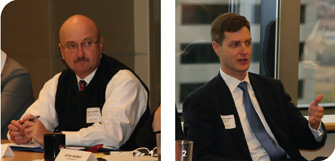
1. Mark Huffer cited the important psychological boost that rails in the streets could give to Downtown developmental efforts. | 2. Jason Klumb came to the meeting with one key message: “Don’t give up” on Kansas City’s efforts to secure a new GSA headquarters in the East Village.
“You have to look beyond this as a transportation project,” said Mark Huffer, business manager for the transportation authority. A streetcar system, he said, would add a powerful intangible factor to continuing Downtown development: Tracks in the street bed “give a sense of permanence,” to redevelopment efforts, he said, generating an extra measure of confidence among developers that their investments will yield solid returns—a key to driving private investment that many agree will be necessary.
Again, it came down to leverage: Such a system, Huffer said, “makes a lot of the other projects we’re talking about today even more feasible.”
Participants generally agreed that effective transportation, combined with a renewed focus on improving walkability, was needed to make inroads with an automobile-centric culture built around two-car households. If people feel like they have to keep two cars garaged Downtown in order to live there, the entire concept of drawing residents there is a failed exercise, they said.
Ferd Niemann, representing Jackson County government at the table, said the effects of a transportation-oriented district would produce a ripple effect of redevelopment a quarter-mile wide on either side of a transit line. But there are other potential lures for government.
“Washington loves a commitment to public transportation,” said the GSA’s Jason Klumb, noting that discussions of a rail line were altering the view of Kansas City from the east, one of community with a stagnant transportation outlook.
Rick Hughes, citing what he called the awesome power of such connectivity, said the area would reap a huge psychological advantage, as well. “It makes the 1.1-mile distance from the convention center to Crown Center seem a lot shorter,” he said.
The Eastern Front
Assessing the prospects for realizing the long-anticipated construction of a new federal building to house GSA in East Village, adjacent to centers of government Downtown, Jerry Riffel said it was a simple question of employment: “Jobs are the key to the middle class, the key to survival of the city and the key to Downtown.”
Thus, securing federal employment with a new $200 million, 500,000-square-foot GSA headquarters was not only about relocating jobs from south Kansas City’s Bannister complex, it was about securing them for the area longer-term, should federal bean-counters start pondering other cities for consolidation efforts.
“The GSA is committed to this proposal,” Klumb told the assembly. “Don’t give up on this one.” As he noted, though, “federally owned” means that the cash for construction must come up-front, a particularly thorny challenge at a time of unprecedented federal deficits.
Jon Copaken, of Copaken Brooks, suggested that even if Congress rejected funding for the project in the short term, federal officials could still achieve a win-win in the area by locking in low rental rates for the long-term, given a nearly 30 percent office-space vacancy rate Downtown. “There may be better economic ways that government can help by not necessarily building new space,” he noted. “It’s a great time to go to landlords with depressed prices on office space.”
Klumb, though, pointed out that federal practice tries to ensure a 50-50 mix of building ownership and leased space. An example of the latter sits not far from East Village—the Bolling Federal Building, which Klumb said anchors 3,000 federal jobs “and will continue to do so for a long, long time.”
The East Village work is already paying dividends with Downtown residents, Dietrich said, pointing to 800 planned apartment units, the first of which just opened. “We’ve created a mixed product” by fostering development of subsidized housing, he said, “now the focus should be on market-rate apartments.”
Closure—and Openings
David Frantze tried to circle back to a sense of priority-setting. But given the multiple interests represented at the table, that was a challenge. Some said the top priority should be residential housing, some said the focus on a relocated UMKC conservatory should take top billing, some saw the transit line, the GSA building or the hotel as the next big thing needed Downtown.
But, as Rick Hughes said in bringing the assembly to a conclusion, “the important thing is to get everybody cast under the vision” for the wide range of improvements still needed to keep the redevelopment momentum going in Downtown Kansas City.
Return to Ingram's November 2011